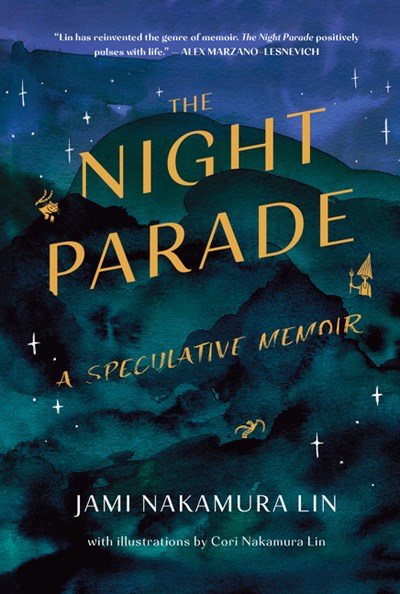[ad_1]
As a child, amidst familial turbulence, I prayed to my mouse plush toy, asking existential questions through wordless telepathy. My family was not religionless—we were Buddhists who attended temple on major holidays—but I found comfort in confiding in this stuffed animal that I associated with wisdom of its own. I understand now, after reading The Night Parade, that rather than contrived idolatry, the mouse served as a helpful foil to my uncertainties and an adaptive means to begin understanding, in my own terms, the issues that my family would not speak of.
I learned about the potential of the speculative applied to memoir in The Night Parade by Jami Nakamura Lin. Through Japanese, Taiwanese, and Okinawan folklore, Lin makes sense of her experience living with undiagnosed bipolar disorder, and later, her father’s cancer diagnosis and decline. The author employs legends, particularly stories of yōkai—supernatural beings that exist between the natural and spiritual worlds—as counterpoints to her family’s shifting dynamics and grief. The same centuries-old tradition in which storytellers used yōkai to explain unaccountable occurrences and phenomena, Lin applies to mental illness, mourning, and community.
I was excited to speak with Lin over Zoom, where we talked about folklore as a way into personal truth, the power and limitations of naming, and the loss and recovery of intergenerational stories, among other topics.

Brian Truong
The book charted new territory for me–expanded my definition for memoir—both from a storytelling tradition and as a practice of understanding oneself, especially from the way it intertwines folklore and the speculative with personal story. How can mythology be a pathway into personal truth? How did you discover this connection?
Jami Nakamura Lin
I stumbled upon using mythology by accident. I had done all this research that I thought was going to be in a YA book based on folklore, and then when I found out my father was dying, I stopped writing for a while. When I wanted to start processing again, it was really hard for me to write until I started using folklore to bounce off of while I was talking about my own story.
I think with mythology, many of these stories are passed down because there’s a kernel of something universal that we stick to. Folklore is often so bare-bones in detail. Because we don’t get a lot of the emotional backstory to what’s happening, it gives us a lot of entry points to use our own context to expand upon it.
Brian Truong
In the book, you mention that you tend to “tell” rather than “show” in your storytelling. Is that related?
Jami Nakamura Lin
Yes, I’ve always loved writing that moves quickly, where the recounting of events moves fast relative to the pages. I think that has to do with my ADHD. I’m drawn to writers like Gabriel García Márquez where so much happens in the span of a few pages. Similarly, in fairytales and folklore, we don’t get scene-by-scene description of action that’s happening. They move at such a fast pace that as a writer, I can retell them, focusing my own lens on what I find interesting.
Brian Truong
The book is propulsive and nonlinear at the same time. How did you go about assembling and arranging the book and its themes?
Jami Nakamura Lin
It was a huge struggle. I wanted to break away from the classic Western inverted “V” structure. I was rearranging little pieces of paper over and over again. It was only until right before my agent and I sold the book that I figured out that I wanted to use the format of Kishōtenketsu, which is a Japanese four-part structure. I was really interested in Kishōtenketsu’s idea of a turn in part three because I knew I was telling two stories—one about my bipolar disorder and one about my father’s death—and I knew that they were connected in my brain around this idea of how we live with things that haunt us.
As I was revising with my editor, the chapter content changed so much, but we never changed the chapter order, which shocked me. My sister had actually completed the art long before I finished writing the book. It kind of forced me to write about a particular yōkai in a given chapter because she’d already painted it. It ended up working out. I just had to dig deep and figure out what had initially married these two concepts in my mind.
Brian Truong
I am reminded of how naming is a type of constraint, particularly how naming yōkai in the book allowed for the acknowledgement of difficult phenomena in your own life. What do you see are the limitations of a name versus the power a name can bestow?
Jami Nakamura Lin
I love the idea of the power that a name can bestow. I feel like that power can also be its constraint, too. I’m really drawn to language because of that. Names are super important to me, where sometimes if I came up with the right name for a chapter, it helped me rethink the whole shape or viewpoint I was coming at it from. With yōkai, before naming, there were all these phenomena we were not necessarily sure of what they were or why they were happening. The folklore scholar Michael Dylan Foster talks about how you might feel a prickle on the back of your neck when you walk past an abandoned place, but until you give it a name and start talking about it with other people, it’s only an individual experience. But once you give it a name, once people start talking about it, then it becomes a yōkai that also brings a community around it.
I think similarly about my bipolar diagnosis. It wasn’t like after I was diagnosed, I had different symptoms than before I was diagnosed, but by giving it a name, it helped me find community and support for it. As far as limitations, I think naming can bring collapse or flattening. I try to use the process of naming as a point of expansion. A name is not the beginning and end.
Brian Truong
In the book, you say, “I know there is a difference between reading about a place and going to a place and descending from a place and being from a place.” What parts of our histories can be lost through relying on intergenerational story sharing? How can research fill in the gaps?
Jami Nakamura Lin
I’ve heard this concern from many people of our generation, often of a diaspora, fearing this idea of authenticity, where if we’re doing research rather than getting the tales passed down from family, then it’s not authentic. It’s something that I still reckon with, though I think the idea of authenticity is often a trap because what makes those stories lost to us are things like imperialism or forced assimilation or even migration. For example, yōkai are so tied to the land, and I feel like many of my family’s stories are stuck in the countries we came from. It’s so hard to bring them here because there are not the same physical signifiers that remind us of them.
I think research can fill in the gaps of what was not passed down to me individually but was written down for a reason. Research and family are not necessarily in opposition to each other. It matters much more to look at the source of where the research came from and how we can use it and not necessarily think about questions of proximity. I also think that the things that I research I can also pass down to my daughter even though my mother did not pass it down to me. We can reclaim stories and access community knowledge that maybe the older generations didn’t have access to and then continue to pass those down in a different way.
Brian Truong
As we tell the stories that we research, how do we honor our diaspora and ancestors without exoticizing or misrepresenting them?
Jami Nakamura Lin
I’ve been trying to really believe in the idea of abundance. I’m not the only person writing these stories. There are so many of us, and hopefully in the future, there’ll be even more of us doing this work and hopefully being encouraged and elevated in publishing. I’m also trying to give grace to myself and remember that I’m trying my best. I could make mistakes or errors, but if I do, then I’ll do my best to fix it and try not to think of it as a huge moral failure where I’ve let down my community. I’m one person writing one story from one perspective. I don’t want the fear of mistakes to be so overwhelming that it stops me from doing the work.
Brian Truong
As you researched and wrote The Night Parade, did you notice any unifying threads between the Japanese, Okinawan, and Taiwanese myths and legends?
Jami Nakamura Lin
One thing is that all three are island nations, which shapes everything because all are surrounded by the sea. As an island, I think you are historically more concentrated and have less influence from abroad. The weather and ocean also shaped many of the narratives because the ocean really made or broke you. One of the differences is that Japan is an imperial nation that took over both Okinawa and Taiwan. Writing this book as a mixed Asian American, it made me reflect a lot more about the legacy of imperialism. For example, moving back only 50 years, at the same time Japanese-Americans were being incarcerated, Japan was incarcerating people in other countries. It lends the sense of interconnectedness and also the structural harms that nations have enacted on each other.
Brian Truong
Is there a yōkai or legend you love that couldn’t make it into the book?
Jami Nakamura Lin
There’s this little yōkai called the Kijimunā. They’re like little red, hairy children that live in banyan trees. They’re kind of mischievous but not evil. Like if you’re a fisherman and friends with Kijimunā, then they’ll help you gather lots of fish, but the fish will all be missing an eye. If you make one mad, then they’ll do rascally things. One thing I find very poignant is that the way to make an enemy of them is to burn down a banyan tree. So as I’m thinking about the world and the climate and environment we’re moving towards, all these natural worlds and wonders that no longer are here, and it really resonates with me that the way to get a Kijimunā’s wrath is if you get rid of their tree. Hopefully it’ll come up in some of my future fiction work.

MEMOIR
The Night Parade
By Jami Nakamura Lin
Mariner Books
Published November 7th, 2023
[ad_2]
Source link

